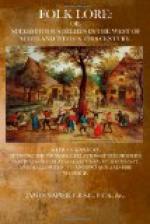“Pictures
oft she makes
Of folk she hates, and gaur
expire
Wi’ slow and racking
pain before the fire.
Stuck fu’ o’ preens,
the devilish picture melt,
The pain by folk they represent
is felt.”
This belief survived in great force in this century, and probably in country places is not yet extinct. Several persons have been named to me who suffered long from diseases the doctor could not understand, nor do anything to remove, and therefore these obscure diseases could only be ascribed to the devil-aided practices of malicious persons. In some cases, cures were said to have been effected through making friends of the supposed originators of the disease. The custom not yet extinct of burning persons in effigy is doubtless a survival of this old superstition.
A newly-married woman with whom I was acquainted took a sudden fit of mental derangement, and screamed and talked violently to herself. Her friends and neighbours concluded that she was under the spell of the evil one. The late Dr. Mitchell was sent for to pray for her, but when he began to pray she set up such hideous screams that he was obliged to stop. He advised her friends to call in medical aid. But this conduct on the part of the woman made it all the more evident to her relations and neighbours that her affliction was the work of the devil, brought about through the agency of some evil-disposed person. Several such persons were suspected, and sent for to visit the afflicted woman; and, while they were in the house, a relation of the sufferer’s secretly cut out a small portion of the visitor’s dress and threw it into the fire, by which means it was believed that the influence of the ill e’e would be destroyed. At all events, the woman suddenly got well again, and as a consequence the superstitious belief of those who were in the secret was strengthened.
CHAPTER VI.
CHARMS AND COUNTER CHARMS.
During these times when such superstitious beliefs were almost universally accepted—when the sources from which evils might be expected to spring were about as numerous as the unchecked fancies of men could make them—we must naturally conceive that the people who believed such things must have lived in a continual state of fear. And in many instances this was really the case; but the common result was not so, for fortunately the bane and antidote were generally found together, and the means for preventing or exorcising these devil-imposed evils were about as numerous as the evils themselves. I have already in a former chapter mentioned incidentally some of these charms and preventives, but as this incidental treatment cannot possibly cover the field, I shall here speak of them separately.




